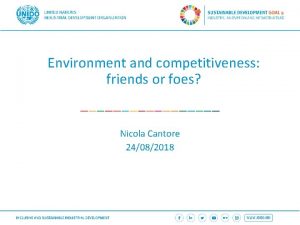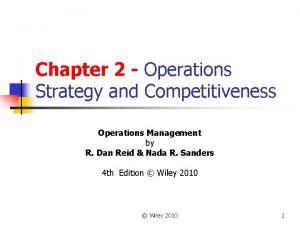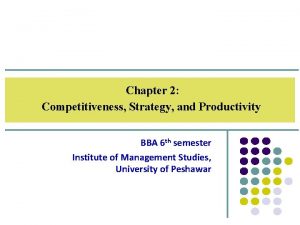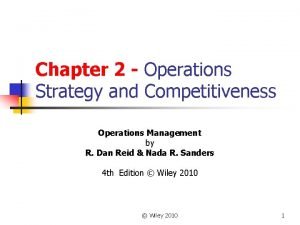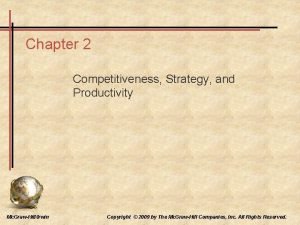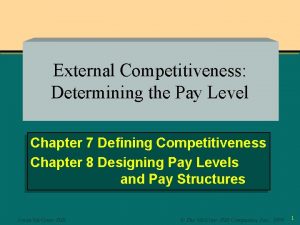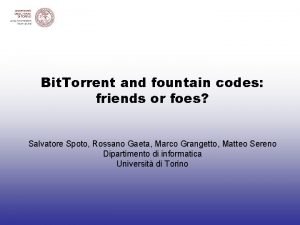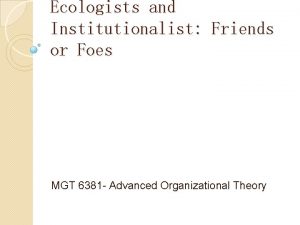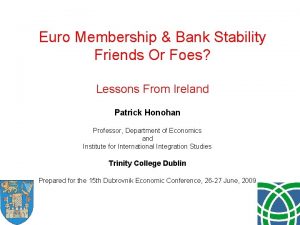Environment and competitiveness friends or foes Nicola Cantore


















- Slides: 18

Environment and competitiveness: friends or foes? Nicola Cantore 24/08/2018

Structure of the presentation • 1. Why are emissions reduction and environment protection often perceived as constraints to industrialization and growth? • 2. Why are emissions reduction and environment an opportunity for industrialization and growth? • 3. Conclusions 2

1. Why are emissions reduction and environment protection often perceived as constraints to industrialization and growth? 3

Emissions reduction requires many options Co 2 e (Gigatons) World Development Report 2010 4

There is ample evidence that environmental regulations induce innovation activity in cleaner technologies, but the benefits brought forward by these innovations do not seem to be high enough to outweigh the costs of regulations for the regulated entities Dechezleprêtre and Sato, 2017 5

Reduction of emissions is normally perceived as a cost for economies… Source: OECD 2014 6

…especially for ambitious emissions reduction targets Source: Mc. Kinsey 2009 7

Renewable energy is often perceived as a costly option By 2020, all the renewable power generation technologies that are now in commercial use are expected to fall within the fossil fuel-fired cost range Source: IRENA 2017 8

2. Why are emissions reduction and environment an opportunity for industrialization and growth? 9

Argument 1: On the consumption side environmental goods can attract the preferences of consumers UNIDO Industrial Development Report 2018 10

Argument 2: On the production side emissions reduction and environment protection require the production and exports of environmental goods UNIDO Industrial Development Report 2018 Cantore et al. (2018) find that environmental taxes reduce imports of environmental goods and increase domestic production 11

Argument 3: High energy prices generate low energy intensity Response of total factor productivity to higher energy efficiency Grubb et al. 2017 12

Argument 3: … Low energy intensity means high total factor productivity… Response of total factor productivity to higher energy efficiency Cantore et al. 2016, Energy Policy 13

Argument 3: … and Low energy intensity means more competitiveness UNIDO Industrial Development Report 2011 14

Argument 4: Greening electrification creates jobs with a lower generation cost per worker Source: Cantore et al. 2017, study on Africa, Environmental Research Letters Generation costs in thousands 2011 USD 15

A joint collaboration between World Bank and UNIDO generated preliminary empirical findings contained in the forthcoming World Bank report “Fiscal policies for development and climate action” 16

3. Conclusions • Environmental and energy policies are not necessarily rivals of industrial policy, they should rather be mainstreamed into it • When environmental and energy policies objectives cannot be fully reconciled with growth and industrialization, accompanying measures may be needed to mitigate the effects on competitiveness • In evaluating environmental and energy policies, policy makers should also take into account social benefits which are not captured by market analyses 17

Thanks! 18
 Nicola cantore
Nicola cantore Penelope pilastro
Penelope pilastro Intro to romeo and juliet
Intro to romeo and juliet Spiderman foes
Spiderman foes Little friends may prove great friends meaning
Little friends may prove great friends meaning Friends of the environment
Friends of the environment Operations strategy and competitiveness
Operations strategy and competitiveness Chapter 2 operations strategy and competitiveness
Chapter 2 operations strategy and competitiveness Labor productivity example
Labor productivity example Operations strategy and competitiveness
Operations strategy and competitiveness Productivity and competitiveness in operations management
Productivity and competitiveness in operations management How do you measure productivity
How do you measure productivity Competitiveness strategy and productivity
Competitiveness strategy and productivity Unitless measure of productivity
Unitless measure of productivity Resource based model
Resource based model Competitiveness, strategy and productivity
Competitiveness, strategy and productivity Financial environment of business
Financial environment of business Chapter 31 apush
Chapter 31 apush External competitiveness
External competitiveness
